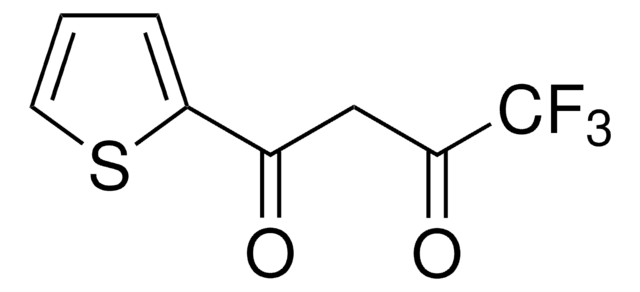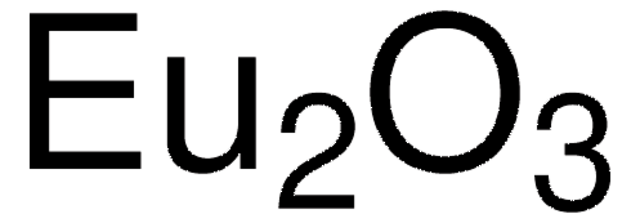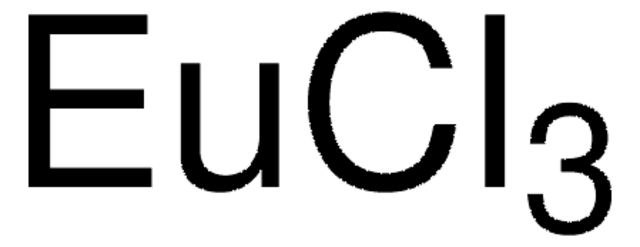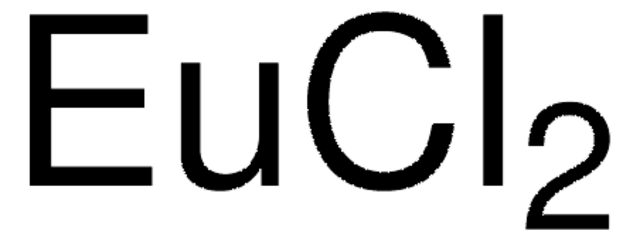254061
Europium(III) nitrate hydrate
99.99% trace metals basis
Synonyme(s) :
Europic nitrate hydrate, Europium trinitrate hydrate
About This Item
Produits recommandés
Qualité
for analytical purposes
Niveau de qualité
Essai
99.99% trace metals basis
Forme
solid
Pertinence de la réaction
reagent type: catalyst
core: europium
Impuretés
≤150.0 ppm Trace Rare Earth Analysis
Chaîne SMILES
[Eu+3].[H]O[H].[H]O[H].[H]O[H].[H]O[H].[H]O[H].[O-][N+]([O-])=O.[O-][N+]([O-])=O.[O-][N+]([O-])=O
InChI
1S/Eu.3NO3.5H2O/c;3*2-1(3)4;;;;;/h;;;;5*1H2/q+3;3*-1;;;;;
Clé InChI
BBGDGFQCQRFYCP-UHFFFAOYSA-N
Catégories apparentées
Application
- A novel strategy for the synthesis of samarium/europium-metal organic frameworks: This study explores the utilization of Samarium and Europium nitrate hydrates in the development of metal-organic frameworks for luminescent sensing. These frameworks are employed for detecting substances like acetone, Cr3+, and Pb2+ in real samples, showcasing potential applications in environmental monitoring and safety (Syed, 2024).
Mention d'avertissement
Danger
Mentions de danger
Conseils de prudence
Classification des risques
Eye Irrit. 2 - Ox. Sol. 2 - Skin Irrit. 2 - STOT SE 3
Organes cibles
Respiratory system
Code de la classe de stockage
5.1B - Oxidizing hazardous materials
Classe de danger pour l'eau (WGK)
WGK 2
Point d'éclair (°F)
Not applicable
Point d'éclair (°C)
Not applicable
Équipement de protection individuelle
Eyeshields, Gloves, type P3 (EN 143) respirator cartridges
Faites votre choix parmi les versions les plus récentes :
Déjà en possession de ce produit ?
Retrouvez la documentation relative aux produits que vous avez récemment achetés dans la Bibliothèque de documents.
Les clients ont également consulté
Articles
Spectral conversion for solar cells is an emerging concept in the field of photovoltaics, and it has the potential to increase significantly the efficiency of solar cells. Lanthanide ions are ideal candidates for spectral conversion, due to their high luminescence efficiencies and rich energy level structure that allows for great flexibility in the upconversion and downconversion of photons in a wide spectral region (NIR-VIS-UV).
The prevailing strategies for heat and electric-power production that rely on fossil and fission fuels are having a negative impact on the environment and on our living conditions.
The rare earth elements impact nearly everyone in the world. All of the people living in advanced technological countries and almost all those living in third world countries utilize the rare earths in their everyday living—the car that one drives (gasoline is refined from oil using rare earth catalysts and catalytic converters reduce the polluting emissions from the automotive exhaust), watching the news on TV (the red and green colors in TV screens), the telephones and computers we use to communicate (the permanent magnets in speakers and disc drives), just to name a few examples.
Global Trade Item Number
| Référence | GTIN |
|---|---|
| 254061-10G | 4061825982779 |
| 254061-1G | 4061825982786 |
Notre équipe de scientifiques dispose d'une expérience dans tous les secteurs de la recherche, notamment en sciences de la vie, science des matériaux, synthèse chimique, chromatographie, analyse et dans de nombreux autres domaines..
Contacter notre Service technique
















